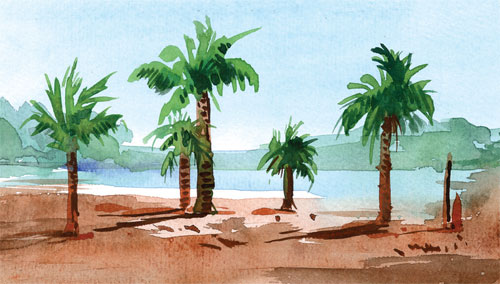|
Learn to draw by Tissa Hewavitarane
Techniques for landscapes in watercolour painting
The basic of watercolour painting is that it allows the paint to flow
easily over the paper. When painting in watercolour we have strictly
maintained that a brush stroke must be allowed to dry before applying
another colour or tone.
|

A simple watercolour landscape in wash |
Secondly, the drawing paper is another important factor. You have to
choose high quality paper that has medium grain where it has enough
texture for paint to absorb. Very thin paper should be avoided since it
wrinkles easily.
A watercolour must always be painted from light to dark. For example,
if you are painting a tree for the leaves, a light green wash is applied
and next the dark colours are put on.
Even for the tree trunk it is the same process.
When the surface is wet the paint spreads. On a dry surface, on the
contrary, the brush strokes can be controlled.
The two techniques applied to any kind of landscape is to use the
correct technique at the right time and place.
If the two techniques are used together with certain confidence it
can pay dividends for the landscape painted, or trees' reflections on
water or the atmosphere in the background of the picture. In doing a
wash, dip the brush in water and load it well before touching a little
colour with the tip of the palette. Then pull it cross the surface
giving some pressure so that the water is released. Move the colour in
the water to dissolve.
Drain the brush, there must not be too much water. Use the wash to
colour the area destined to be the top of the tree. The brush strokes
have to be uniform and cover all the areas.
In general, the background of landscapes such as the sky or water are
painted on wet paper.
On the surface, the tone and merge of colour can be done gradually
which will show the beauty of the landscape.
It is difficult to use just the technique of painting on a wet
background or on a dry background in any given painting. Usually both
are used at the same time to achieve the desired effect.
The painting shown here is a simple wash drawing done without any
details.
Observe the trees painted with light wash and the tree trunks with a
light wash of burnt sienna. The whole painting is done only with three
colours-burnt sienna, ultra marine blue and hookers green.
This is to give the student or beginner to study how to complete a
painting with minimum colours. The paper used is Kent with 250 grams and
Sable hair brushes Nos. 1, 2, 6 and 3.
Always remember that mixture of two primary colours produce a
secondary colour. Therefore, yellow mixed with Cyan gives the colour
green. |

